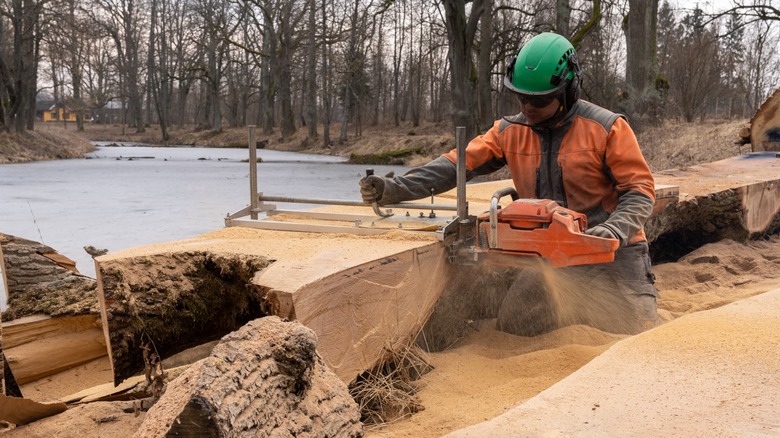5 Unexpected Uses For Chainsaws
Chainsaws are versatile and valuable tools. You'll find people using them to fell trees, cut firewood, clean up storm damage, and perform all sorts of other tasks. Construction and utility crews find plenty of use for them, too.
Chainsaws come in different sizes and styles to fit various needs. There are popular mini chainsaws you can operate with one hand and giant models with guide bars nearly 4 feet long. Chainsaw power sources vary, including corded, battery electric, and gasoline, with gas being the most popular. Gas-powered chainsaws fall into two engine design groups: two-stroke and four-stroke. Two-strokes are the most common, but four-strokes continue to gain popularity among consumers.
With such a variety of chainsaws, it's only logical that their services include activities other than trimming trees and cutting firewood. While some of the following five uses won't shock you, others are entirely unexpected. Have you ever used a chainsaw for any of these purposes?
Sculpting wood and ice
Chainsaw artists use chainsaws to sculpt wood or ice into aesthetically pleasing shapes. Given the rustic nature of chainsaw carvings, these shapes typically represent woodland creatures such as bears, moose, elk, eagles, and owls. However, some artists like to create likenesses of smaller animals with a few mythical creatures thrown in for good measure. There's something majestic about a 10-foot-tall Sasquatch carved from a 100-year-old beetle-killed pine tree and dragons sculpted from ice blocks.
If you try your hand at chainsaw sculpting, using a small, lightweight chainsaw is best. Electric chainsaws have pros and cons, but light weight and flexible charging make them a good option for sculpture. Using a big chainsaw to remove large chucks is okay, but a mini chainsaw allows precise control with less risk of costly mistakes. We'd also advise wearing all the recommended personal protective equipment indicated by the chainsaw manufacturer.
Portable chainsaw mill
If you have a chainsaw and some wood that's larger than you need, you need a portable chainsaw mill. Portable chainsaw mills allow you to turn whole logs into useable lumber. While specifications vary among chainsaw mill manufacturers, most accommodate chainsaws in common sizes.
Portable chainsaw mills are a great way to get lumber for off-grid builds. Better yet, finishing work with a chainsaw mill on projects like feature walls and decorative beams reduce the issues introduced to a build by fresh-cut, uncured lumber.
Milling lumber with a portable chainsaw mill does have some downsides. One negative is the potential for damaging your chainsaw. Small chainsaws with low horsepower engines or electric motors quickly overheat and fail under the stress of extended rip cuts. You'll be better off with a larger model chainsaw from a major brand. Another con is the potential health hazard from exhaust fume exposure. Chainsaw milling requires the saw to run at maximum rpm to generate peak power. Wearing a quality respirator while chainsaw milling is strongly recommended, but it will add to the cost.
Finally, there's the issue of efficiency. The best chainsaws for milling have large displacement engines and long guide bars costing up to $2,200. The cost of the chainsaw mill, milling saw chain, respirator, and other required tools results in an investment that quickly approaches that of a more efficient gasoline-powered bandsaw mill.
Cutting ice for ice fishing
Before everyone had an electric refrigerator in their home, people would venture onto frozen lakes and rivers every winter to harvest ice using saws. While times changed and the need for harvesting blocks of frozen surface water faded, some hardy souls still trek onto the ice in the dead of winter to go fishing. In the absence of a powered auger or large motorized drill, a chainsaw can be a handy gadget to have along for ice fishing.
Using your chainsaw to cut through lake or river ice requires some considerations. First, drain and flush any bar and chain oil from the reservoir to prevent water contamination. Next, ensure your guide bar is long enough to reach through the ice. Finally, wear all recommended personal protective equipment and footwear that resists slipping on the ice. You do not want to slip while operating a running chainsaw.
Field-processing large game
Big-game hunters, especially those pursuing white-tailed deer east of the Rocky Mountains, use chainsaws for various reasons. Uses included habitat management activities like opening the forest canopy to increase forest floor plant diversity and hinge-cutting trees to create dense bedding areas. Mini-chainsaws excel at camping and overlanding jobs, delivering full-size chainsaw performance in a handheld package.
One unexpected use for battery-powered mini chainsaws is their addition to large game field processing kits. Upon taking a large game animal, it's vital to process and chill it as quickly as possible. Part of that is breaking down the carcass into manageable pieces, usually called quarters (though it often results in more than four parts). Cutting through thick bones like femurs and the pelvic bone is tough going with an axe or hatchet. Today's powerful mini chainsaws both make the process easier and help hunters avoid wasting any part of their kills.
Powering a bicycle
If you have a donor bicycle, an unneeded chainsaw, and some fairly serious DIY fabrication chops, you could turn your saw into a working vehicle.
With the proper gearing, chainsaw motors above 80cc displacement and generating over six horsepower could power a slick go-kart. The high revs and low torque of chainsaw motors make them even better matches for lightweight transportation like mini-bikes and bicycles. That includes both gas-powered and electric motors: in the latter case, breaking down a chainsaw could let you turn your normal bicycle into an e-bike.
It's unlikely that you'll find a kit designed to insert your chainsaw engine into the bicycle or mini-bike of your choice. This project will require expert-level fabrication, likely including machining, welding, and mechanical engineering. Still, YouTube abounds with quality tutorials, and pulling off a build like this guarantees automatic legendary status when you ride around your local car show or track day.





